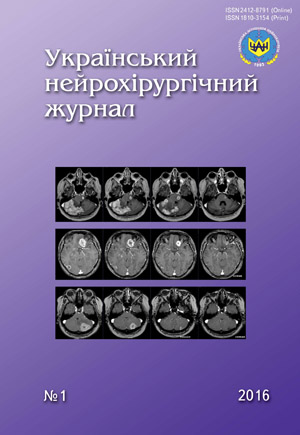Features of surgical treatment of cerebellar astrocytomas in children of the first years of life
DOI:
https://doi.org/10.25305/unj.61888Keywords:
astrocytoma of the cerebellum, children of the early age, the results of surgical treatmentAbstract
Introduction: Astrocytomas make up to 30-50% of all brain tumors in children and remains one of the actual problems of pediatric neurosurgery.
Objective: To conduct a retrospective analysis of the treatment of cerebellar astrocytomas in children of early age during 30 years, to identify the factors determining the prognosis of the disease.
Materials and methods: Results of treatment of 83 children of early age, operated for astrocytomas of cerebellum in the Pediatric Department in 1980-2009 years were analyzed. Male patients were 48 (57.8%), female — 35 (41.2%). Benign astrocytomas are diagnosed in 67 (80.7%) cases and malignant in 16 (19.3%). Astrocytoma of the cerebellum in 43 (51.8%) children contained a cystic component. Postoperative mortality over a 30-year period was 15.8%. Catamnesis was analyzed in 65 patients in terms in average 6.1 years. The evaluation of quality of life was based on a scale Yu.A. Orlov (2007).
Results: The total removing of the tumor was done in 61.9% of patients, subtotal in 26.3%, partial in 11.8%, biopsies of tumours in 1.2%. Shunt surgery complement the removing of tumors in 40.8% cases. Postoperative mortality rate decreased from 18.2% in 1980-1989. to 6.7% in 2000-2009. In 1980-1989 years total removal was in 35.4%, in 2000-2009 in 66.7%. Survival at 1 year after operation was in 93.8%, 2 years – in 86.1%, 5 years – in 67.7% of cases. The good quality of life was noted in 21 (32.3%) of the children, satisfactory in 35 (53.8%), poor in 7 (10.8%) and the vegetative state in 2 (3.1%) children.
Conclusions: The amount of removal of the tumor, the degree of malignancy, presence of cystic components affect the quality and duration of life of children of early age with cerebellar astrocytomas.
References
1. Musial-Bright L, Panteli L, Hernaiz Driever P. Pediatric low-grade glioma survivors experience high quality of life. Childs Nerv Syst. 2011;27(11):1895-902. [CrossRef] [PubMed]
2. Rickert C, Paulus W. Epidemiology of central nervous system tumors in childhood and adolescence based on the new WHO classification. Childs Nerv Syst. 2001;17:503-511. [CrossRef] [PubMed]
3. Rickert C. Terashima K, Chow K, Jones J, Ahern C, Jo E, Ellezam B. Long-term outcome of centrally located low-grade glioma in children. Cancer. 2013;119(14):2630-8. [CrossRef] [PubMed]
4. Due-Tonnessen BJ, Lundar T, Egge A, Scheie D. Neurosurgical treatment of low-grade cerebellar astrocytoma in children and adolescents: a single consecutive institutional series of 100 patients. J Neurosurg Pediatr. 2013;11(3):245-9. [CrossRef] [PubMed]
5. Pillai S, Metrie M, Dunham C, Sargent M, Hukin J, Steinbok P. Intracranial tumors in infants: long-term functional outcome, survival, and its predictors. Childs Nerv. Syst. 2012;28(4):547-55. [CrossRef] [PubMed]
6. Rivera-Luna R., Lopez E., Rivera-Marquez H., Rivera-Ortegon F., Altamirano-Alvarez E., Mercado G., Covarrubias G., Rueda-Franco F., Marhx-Bracho A., Gutierrez P. Survival of children under 3 years old with medulloblastoma: a stady from the Mexican Cooperative Group for Childhood Malignancies (AMOHP). Childs Nerv. Syst. 2002;18:38-42. [CrossRef] [PubMed]
7. Varan A, Akalan N, Soylemezoglu F, Zorlu F, Yalcin B, Akyuz C, Kutluk T, Buyukpamukcu M. Central neurovous system tumors in patients under three years of age: treatment results of a single institute. Pediatr. Neurosurg. 2006;42(2):89-94. [CrossRef] [PubMed]
8. Orlov YuA. [The quality of life of children operated for neurosurgical pathology]. Ukrainian Neurosurgical Journal. 2007;(3):63–5. Ukrainian.
Downloads
Published
How to Cite
Issue
Section
License
Copyright (c) 2016 Andrii Shaverskyi, Yuriy Orlov, Leonid Marushchenko, Viktor Morgun

This work is licensed under a Creative Commons Attribution 4.0 International License.
Ukrainian Neurosurgical Journal abides by the CREATIVE COMMONS copyright rights and permissions for open access journals.
Authors, who are published in this Journal, agree to the following conditions:
1. The authors reserve the right to authorship of the work and pass the first publication right of this work to the Journal under the terms of Creative Commons Attribution License, which allows others to freely distribute the published research with the obligatory reference to the authors of the original work and the first publication of the work in this Journal.
2. The authors have the right to conclude separate supplement agreements that relate to non-exclusive work distribution in the form of which it has been published by the Journal (for example, to upload the work to the online storage of the Journal or publish it as part of a monograph), provided that the reference to the first publication of the work in this Journal is included.









